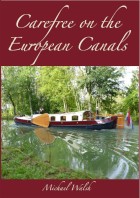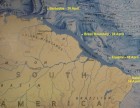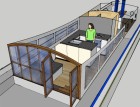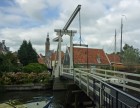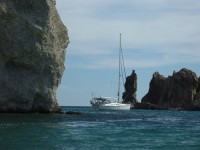Sequitur
Michael & Edi have headed out on a slow, thorough exploration of the globe.
| Vessel Name: | Sequitur and Zonder Zorg |
| Vessel Make/Model: | 2007 Hunter 49 and 1908 Wildschut Skûtsje |
| Hailing Port: | Vancouver, Canada |
| Crew: | Michael Walsh & Edi Gelin |
| About: | For our current location click, on Map & Tracking, then on the Google Earth logo. |
| Extra: | Follow us on Twitter: Follow @YachtSequitur |
| Social: |
13 January 2014
Another New Book Released
I am delighted to announce that my new book: Carefree on the European Canals is now in print and is available on Amazon.com, Amazon.ca [...]
26 April 2013
New Book Released
The proof copy of my new book arrived by courier today. I have approved it and it is now listed on Amazon for pre-order, with a publication date of 30 April. It is a rather large book at 680 pages in an 8.5 by 11 inch format with 315,000 words illustrated by over 2400 colour photos, charts and maps. [...]
24 April 2013
One Year Out of Brazil
One year ago today we sailed Sequitur out of Brazil after enduring more than six weeks in the least-friendly country that we had experienced during our three-year voyage. In the early evening of 24 April 2012 we crossed the line on the chart dividing Brazil from French Guyana and breathed a huge sigh [...]
27 October 2012 | Harlingen, Friesland
Planing a Metamorphosis
We have added a new post to the Zonder Zorg blog at: Planing a Metamorphosis.
29 September 2012 | Sneek, Netherlands
Onward to Friesland
We have arrived in Friesland and have added a new post to the skûtsje's blog at: Onward to Friesland
19 September 2012 | Hoorn, Netherlands
North From Aalsmeer
We have moved northward from Aalsmeer and I have added two new posts: Heading North From Aalsmeer and North From Amsterdam
13 September 2012 | Aalsmeer, Netherlands
Taking Possession
We are back in the Netherlands, and I have added some new posts to the ZonderZorg blog at: Taking Possession and Settling-In and Making Plans
20 August 2012 | Sequitur: St Augustine, USA - Michael & Edi: Vancouver, Canada - Nieuwe Zorg: Aalsmeer, Netherlands
Added a New Website
We have added a new website: Skûtsje ZonderZorg. Zonder zorg in Dutch means without worry. Our intention with the site is to provide a place to share some of the history, geography and culture of the skûtsje as we discover it. We will also use this place to document [...]
11 August 2012 | Sequitur: St Augustine, USA - Michael & Edi: Vancouver, Canada - Nieuwe Zorg: Aalsmeer, Netherlands
Still More Skûtsje History
We continued to attempt to track-down Douwe Albert Visser, who was the owner of Nieuwe Zorg in 1941 when she was re-registered. One of the problems we repeatedly encountered in our online searches was the effect of currently having Albert Visser and two Douwe Vissers as very competitive skûtsje racers, [...]
10 August 2012 | Sequitur: St Augustine, USA - Michael & Edi: Vancouver, Canada - Nieuwe Zorg: Aalsmeer, Netherlands
Some More Skûtsje History
While I was researching the history of Nieuwe Zorg, I finally found her first registration details obscured by an apparent typographical error in a transcribed online spreadsheet. She was listed as having been built in 1901 instead of 1908. I emailed the webmaster of the [...]
Exploring Machu Picchu
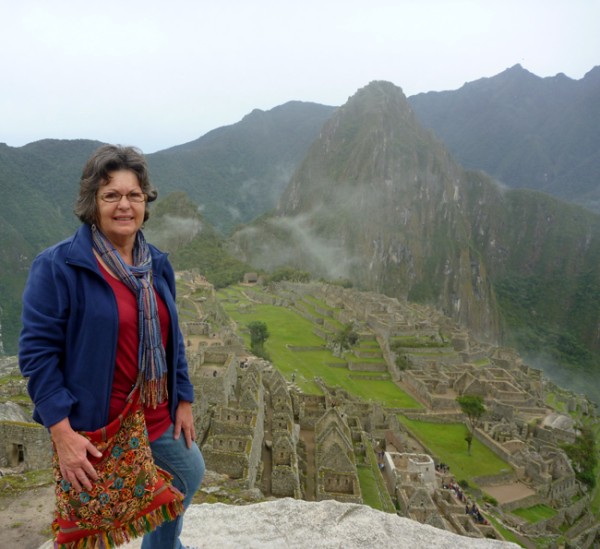

Bingham's 1911 photograph of the overview of the site was burned in my memory. After our 1970 expedition to Peru had fallen through, I had almost forgotten about my desire to visit Machu Picchu, but when I met Edi in 2008, and learned that she had visited the ruins in 1979, my interest re-surfaced.

And here I was among the ruins of Machu Picchu!

After drinking-in the wonder of the place and wallowing in the emotion of being there, we paused to photograph some of the llamas that were busily tending the terraced lawns.

As the mists rolled in, we started our descent into the main part of the ruins.

We came around a bend on a terrace, and there in front of us was a familiar face. Because we were so out-of-context, it took a few seconds to place the face, which belonged to Ken Garfinkle, a member of the Bluewater Cruising Association. We had last seen him in Vancouver Island's Barkley Sound in July of 2009, after we had completed our shakedown sail out Cobb Seamount and back.

After comparing notes of problems with boat fit-out, we continued on our separate ways. As we descended into the main ruins, the mists were beginning to obscure Wayna Picchu.

We made our way across the central plaza, giving the main part of the ruins a miss on our way past. We headed directly to the registration booth for the climb to Wayna Picchu at the far end of the site. Only 400 people are allowed to climb the peak each day, and we wanted to be among them.
I had read that there is a scramble during the high season, with people running from the busses to the booth to get into the line. Because it was nearing low season, we had been able to climb to Hut of the Caretaker of the Funerary Rock and explore that area before heading to the booth. We signed-in as number 66 and 67 and started along the trail to the peak as it continued to be enveloped in cloud.

We first had to descend into a narrow col, losing a bit short of 100 metres in the process. The summit of Wayna Picchu is at 2720 metres, about 300 metres above the main portion of the ruins. With the dip into the col, we now had nearly 400 metres to climb, which is reported to require an hour to an hour-and-a-half.

The trail is very well-made and in an excellent state of repair. Where it steepens, there are steps, many of which were built by the Inca.

Pausing along the way to smell the flowers gave us wonderful excuses to rest.

In one place steps were hewn into a steep slab, which would otherwise have been difficult and dangerous to traverse. At the steep and exposed sections, heavy wire rope handrails, some 2cm in diameter are pinned to the rocks, and make the passage safer and easier.

After 25 minutes on the trail, we came to a sign indicating that the top was 25 minutes away. We were well ahead of the estimated time required. Not bad for a couple in their mid-sixties!

Shortly we emerged into an area of ancient Inca walls and other structures, and our pace slowed as we examined them in awe.

Then high above us, we saw the remains of a house perched on the brink. Very steep steps led up to it past what appeared from below to be agricultural terraces.

We continued up.

... and up through increasingly interesting ruins.

Gradually we rose above awe inspiring views back down on ruins with the Urubamba River far below through the mists.

And still we were led higher. By this time we had lost all awareness of any tiredness or altitude-induced problems.

We came around a bend and the way forward was through a very low tunnel, which required us to bend nearly double.

As the tunnel led into the rock, it narrowed and gained in height, but began to lean to the left. Then a set of steps partly carved in the rocks and partly laid, led us up and out of the tunnel...

... and into the daylight.

The Incas had found an ingenious route past a very steep block. On top of it they had built agricultural terraces, making use of every bit of space possible.

We paused to look down on the main site of Machu Picchu and on down into the valley bottom.

We arrived at the summit and took a breather. Edi found a wonderful seat that had been hewn into the surface of a large sloping rock.

I stood on the highest point drinking-in the serenity, sensing the sanctity of this Inca holy place...

Suddenly our peace was disturbed by a cell phone ringing and then by the all-too-common annoyance of someone shouting into his phone. The Inca gods cringed. The phone call continued to disturb the peace for a couple of minutes, and then probably realizing the roaming charges he was building-up, the man terminated the call.

The mists from the jungles below had mostly cleared, giving us spectacular views down on the ruins of Machu Picchu and the Urubamba River.

Below us were the ruins of an Inca house, and we headed down a very steep set of steps to look at it.

Its real estate listing might read: A solidly-built older home with a bright, open plan with huge skylights and spectacular views over the valley.

We continued to be amazed by the quality of the Inca masonry, and by the geometric precision of the trapezoidal doors, windows and niches. These structures have withstood many earthquakes, which over the centuries have destroyed much else in Peru.

There was a wonderful view of the river valley through the window from inside the house.

We continued down.

The views in all directions were wonderful.

As we descended, the main site of Machu Picchu was emerging from the mists.

The way down was very steep, and we wondered about the Incas coming and going with heavy loads.

There was no need for caution signs; the views of the route down screamed for it.

The entire site had been surveyed in 2005, and we saw many datum pins.

We continued down through awe-inspiring architecture.

Seeking to see even more, we took an alternate route and scrambled down the steps on the terrace faces.

And then we met Anna, our Russian lady from the train, on her way up.

She asked me to take a picture of her in front of the view that was depicted on her T-shirt.

We continued down to the col and across it and started the climb back up to the main site. On the way up, we arrived at a fork in the trail, and decided to follow the route up Huchuy Picchu, the lesser peak between Wayna Picchu and Machu Picchu.

The trail was less well made than the one up Wayna Picchu, but we had soon risen high enough to start getting views over Machu Picchu.

The way was steep, with high steps, narrow places and plenty of exposure. At one point there was a high-angle smooth slab up which the trail led. There was a rope hanging from an anchor at the top, and we used it as layback aid to walk up the slab.

We reached the summit and were rewarded with views back at Wayna Picchu in the one direction and down upon Machu Picchu in the other.

The mists had finished rising, and the clouds were thickening above the peaks, getting ready for their afternoon rain.

We looked past our toes and down to the Urubamba River some 600 metres below, and decided it was time to start heading down.

We slowly worked our way through the main ruins, weaving a zigzag route leading toward the exit.

At every turn we saw amazing examples of the Inca masonry skills.

The structures had been so well built that they have withstood many earthquakes over the centuries.

Always looming above the ruins was the peak of Wayna Picchu.

The mists has finished rising from the valleys, and the layer of cloud overhead was thickening and darkening.

The masonry varied from utilitarian using smaller stones, to masterfully crafted using precisely surfaced and fitted large blocks.

Some of the stones are two metres and more in height and width.

And still Wayna Picchu watched over us.

... and imposed itself into many of our photos.

Edi found a lovely, airy balcony hanging over the precipice.

We climbed to the Intihuatana, the Hitching Post of the Sun. This carved rock is believed to have been used by the Incas as an astronomical observatory, its precisely carved and aligned faces being used to line-up the celestial happenings.

We spotted below us a strikingly different structure; one made with white stones and having curved walls. This is the Temple of the Sun, and it is reputed to contain some of Machu Picchu's finest stonework.

We descended to it.

Below the Temple we examined a carefully carved cave called the Royal Tomb, which has step-shaped altars and in its walls, sacred niches.

We entered and examined one of the few buildings that has been fitted with a roof, replicating as closely as speculation allows, the type of roof that might have been used by the Incas half a millennium ago, when Machu Picchu was inhabited.
We then walked along an agricultural terrace to the entry gate, arriving there just as the rain began to fall. Our timing was impeccable. We had spent just over eight hours wandering among the ruins, enjoying the splendour of the place while the weather cooperated with our every wish. The mists had waited for us to have an overview of the ruins before they began rising, then as we climbed Wayna Picchu, the cloud cover had blocked the sun, making our climb cooler and easier. On the summit of the peak, the mists had played a magical hide-and-seek game with the ruins, and through the afternoon the rains had waited until we had completed our explorations and had arrived at the exit.

An empty bus had just pulled-up as we arrived in the loading area, and we boarded and sat in the back seats so that we wouldn't be bumped by all the packs as people boarded. While we waited for it to load, Edi again took out her knitting and continued with a sock. Each time she wears it, she will be reminded of this fabulous day on Machu Picchu.

